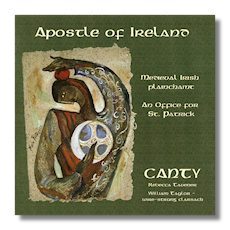
The Internet's Premier Classical Music Source
Related Links
- Latest Reviews
- More Reviews
-
By Composer
-
Collections
DVD & Blu-ray
Books
Concert Reviews
Articles/Interviews
Software
Audio
Search Amazon
Recommended Links
Site News
 CD Review
CD Review
Apostle of Ireland

Hymns, Antophons, Responsories, Magnificat Antiphons, Invitatory
Canty
William Taylor, wire-strung clarsach
Rebecca Taylor
Divine Art DDA25065
This CD is a portrait of the Irish patron saint, St. Patrick. Or rather, it's a collection of pieces – almost 40 items from medieval Offices comprising two Vespers, Matins and Lauds – exemplifying ways in which liturgical works a century after the Saint's death reflected common understanding of his life and significance.
We actually know very little about St. Patrick: that he was not Irish; that he was born towards the end of the fourth century CE in Britain of a family organized under the influence of the waning Roman empire and probably subject to Irish incursions and the predations of pirates; the latter apparently enslaved him into Ireland, from where he escaped, spent some time in France before returning to Britain. By 432 he had taken up missionary work in Ireland and had been consecrated as Bishop. It seems as though his work converting the local aristocracy to christianity and overcoming persistent tribal dangers quickly became legendary. He was aided by an effective pragmatism, and by skills at organization. After his death (probably in 461), these qualities, and his great piety, contributed to a widening and at times mythic reputation. But St. Patrick's has come to have a "reach" greater than across Ireland… he is also patron saint of Nigeria, Montserrat, excluded people and engineers.
The Office for St. Patrick consists of a collection of Propers sung at Matins and Lauds (night-time and at dawn) and during the first and second Vespers in the evening. Because Matins were the most extensive part of the service (lasting over two hours), we necessarily get excerpts on this CD. They're taken from manuscripts held at Trinity College Dublin (chiefly TCD 79, 80). They are of fifteenth century origin. Significantly, the Office presented here is the only known extant such liturgical work from medieval Ireland. That would be reason alone to want this well-produced CD if it weren't for the skill and spontaneity of the performers on this CD; they make it a delight.
Canty is a Scottish group with both an affinity to the celtic world of St. Patrick and a desire to emphasize the Caledonian connections which can be proved (or assumed) for St. Patrick. Furthermore, the arrangements – with improvised celtic harp, for example – necessarily draw on what Rebecca Tavener, Canty's director, suggests was the "influence [… of] centuries of secular bardic practice". She writes, "We feel there is no reason to suppose that this most Celtic of instruments might not have been in use in the performance of an indigenous chant repertoire for several centuries." The music on this CD, though, is not folk or "crossover" in any sense. It has necessarily been put together with a degree of speculation. The chant is mostly sung with equal notes; the voices are all those of women. Drone has only been added when Canty felt that it actually added something. The text, in other words, has been allowed to dictate the overall sound. And, however familiar we may be with these texts from many a liturgical setting, this is all to the good. It aids clarity, expressiveness and impact.
The singing is clear, crisp and very communicative. Each singer is clearly traveling in the same direction, on the same journey, as the others are – and as is William Taylor, the harpist. There is a clear and well maintained sense of purpose in the articulation of each of the texts. The style is relaxed. The unison singing very beautiful. The recording made with an appropriate amount of intimacy and delicacy without ever breathing at the listener. At times the music, most of which is plainchant and simple cantus firmus, is redolent of Hildegard. Although not imbued with her ecstasy – quite – such pieces as the Magnificat antiphon Sis pro nobis sancte Patrici [tr.10] have a rarified refinement that does stop one in one's tracks in that way. But the attack and engagement of Canty is a long way from that of Anonymous 4 in their "11,000 Virgins" or "Origin of Fire" performances. The singers of Canty (who have also a recording of Hildegard on Dorian 93232, by the way) are softer, more feminine and more confident, almost. Because of this, they convey a humility and reverence which aptly fits the gentle and assured nature of the music.
So what we hear is segments of the Office. But this is enough to convey the majesty, conviction and peculiar mystery of this music, much of it slow and meditative – the sinuous and reflexive Egregius Christi miles responsory [tr.16], for example, you wish would never stop. This also means we get ample variety and an excellent idea of what such services might have meant to celebrants five hundred and more years ago. This CD is not about atmosphere, though; it's a valid and well-executed collection of spare yet tuneful, melodically inventive and sophisticated music that is sure to please all lovers of early choral music. The CD comes with an attractively-produced booklet with texts in both Latin and English and a useful introductory essay. Recommended both for the rarity of repertoire and completely successful execution.
Copyright © 2008, Mark Sealey




















